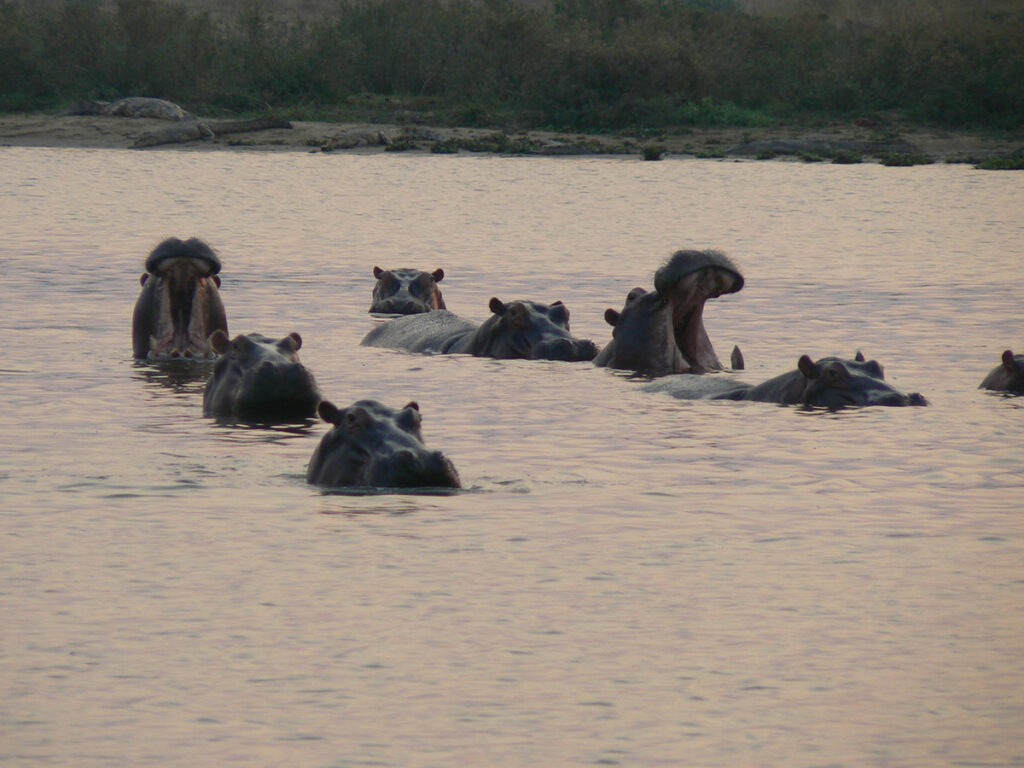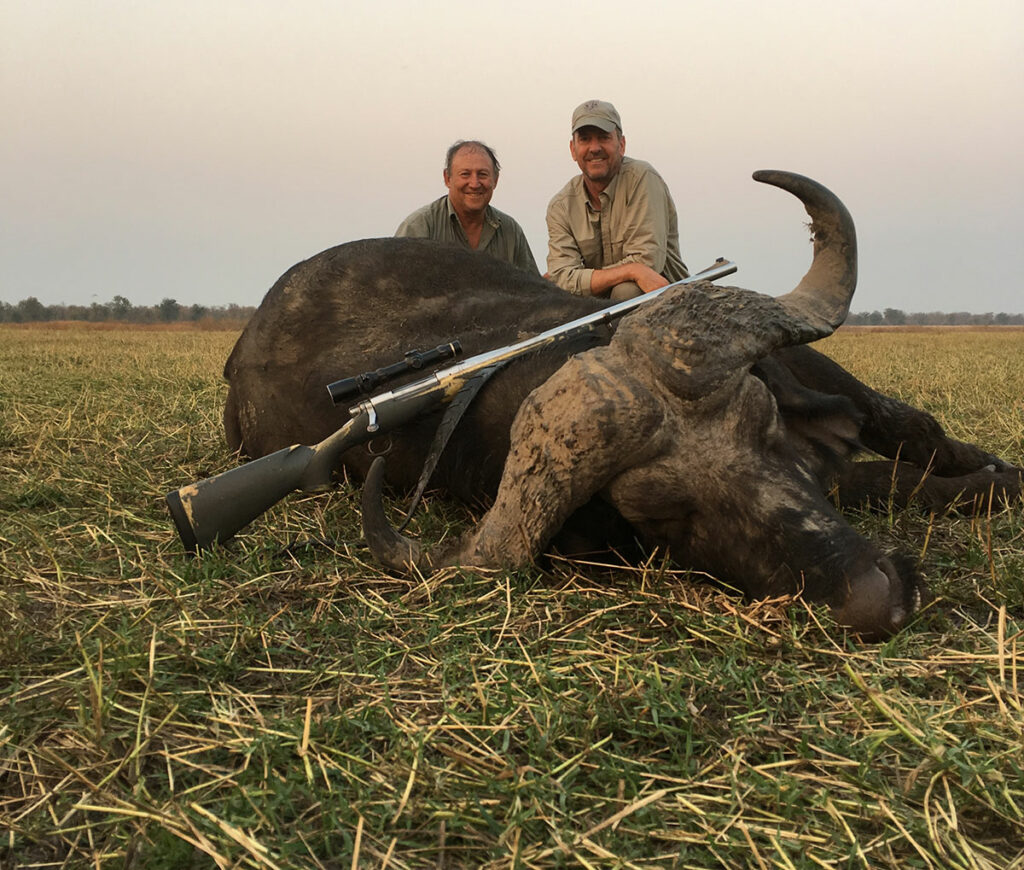Conservation and Buffalo Hunting in Zimbabwe
As thrilled as I was to fulfill my dream of hunting Cape buffalo, I came away with something even greater—a deep appreciation and respect of outfitters, such as Corris Ferria, and their crucial role in preserving habitat and wildlife through sustainable hunting.
The Communal Areas Management Program for Indigenous Resources (CAMPFIRE) is a Zimbabwean community-based natural resource management program. It is one of the first programs to consider wildlife as a renewable natural resource, while addressing the allocation of its ownership to the indigenous population. In short, it promotes sound wildlife management as a way to better the community and discourage poaching.

The numbers for conservation are undeniable. In 2017, Track-A-Hunt Safaris, run by Corris and his wife, Hilary, contributed 27 tons of meat to the local village. Corris and Hilary employ 14 people in a country which has a 90 percent unemployment. Ninety cents of every dollar paid by a hunter in trophy fees goes back into the village for schools, infrastructure and operating expenses. In light of the economic disaster that has fallen on Zimbabwe, it is outfitters such as Track-A-Hunt Safaris who not only provide much needed currency, but also personnel to conduct anti-poaching patrols in both hunting and non-hunting concessions.
Corris and Hilary know that sustainable hunting and fishing are key to the community and the wildlife living on the shores of Lake Kariba. There is a great need to preserve habit and an equal need to combat poaching.
During my visit, after each morning’s hunt we patrolled the lake shore for illegal nets, which unfortunately were plentiful. We collected nets into piles and burned them to prevent illegal fishing, but as well as protect other wildlife from becoming entangled in the monofilament. When hunting, we were also on the lookout for signs of poaching. In the photography-only concession adjoining ours, Corris’s staff removed more than 60 snares.
To be able to hunt Cape buffalo has been a life-long dream. Ever since I could carry a single-shot .22 in pursuit of cottontail rabbits, I imagined myself on the plains of Africa. I never knew what African country I conjured up in my mind’s eye. I just knew it was Africa.
There is something special about Africa. It is difficult to put into words the rawness of the land, the smell of a mopani wood fire and the night sky that is so filled with stars that they seem to envelope you. It was why I chose Zimbabwe.
The name Track-A-Hunt Safaris is no accident. You hunt old school. We would leave just before dawn in a Land Cruiser and look for tracks left by buffalo during the night. A fresh track is one that shines just as the morning light touches the edges. We were looking for Dugga Boys. Dugga is Shona for “mud,” and old bulls have a color of black-grey skin mixed with dried plaster. The Dugga Boys are old bulls that have been kicked out of the main herd or simply grew old and did not want to tangle with the newer generation. Hunting for Dugga Boys does not take breeding bulls out of the main group, which, once again, is sustainability in action.
Dugga Boys usually travel in small groups ranging from two to four animals. Dugga Boys may be old and fierce, but they’re not stupid. Additional bulls mean more eyes and noses to detect lions and hunters. When you cut a set of tracks that has a distinctive, squared-off front edge of an old bull, the walking begins.
The first morning we cut tracks, to our surprise, two Dugga Boys were still nearby. As we made our way through the dry mopani leaves, the wind began its fickle ways. The bulls were still 100 yards off in the forest, but they quickly located us and began to move. Buffalo are not subtle when they sense danger and when the wind moved to our backs and the bulls decided the mountain was safe haven. To see a 1,500-pound animal move with such speed up the steep rocky slopes was awe-inspiring. These two bulls moved faster than a man could keep up and were quickly lost over the first ridge, not to be seen again during my stay.
This was to be the narrative of our hunt: Up early cutting tracks, then on the move trying to play an ever-shifting wind while attempting to walk quietly on dry leaves. We patrolled the lake shore on our return to camp for a quick bite, then headed out again when the temperature began to drop.
It’s during these times of heat, thirst and wondering if a stalk is going to produce an opportunity for a shot, when the subtleties of hunting emerge. As we crept on our hands and knees in an attempt to avoid the sharp eyes of a pair of young bulls, I noticed our head tracker gently picking up thorns and moving them out of the way so that I, the client, would have a clear, pain-free path.
It’s one thing to walk with boots across the terrain, but when on all fours, every thorn is made painfully present. As I thought of complaining to myself with every stab, I looked ahead and saw Corris in the lead wearing only shorts and a short-sleeved safari shirt.

On the afternoon of the sixth day, opportunity arrived. The wind had shifted from calm eddies that were our nemesis into a steady breeze. This we could work with. An old bull we had seen two days earlier was traveling with some younger bulls on their way to test the status of the main herd. We made a large loop and as the sun was waning, used the cover of a dry creek bed to move close.
The bulls knew something was amiss. If they moved right, we would lose them again to the cover of the forest. If they moved left, we would have a small window for a shot. They moved left. I settled the crosshairs on the lower third of the bull’s chest and squeezed the trigger. The recoil of the 416 shifted me back and upward. When I came back down, I saw the bull stumble straight back. I looked at Corris and he said the shot was good. I hoped beyond hope that he was right.
The other bulls faced outward in a protective stance, and we had a nervous 10-minute standoff. When they finally moved off, my bull was revealed on the ground.
The mixture of emotions came next. I had fulfilled a dream, but the recognition of taking such a grand old bull is another emotion altogether. We took pictures and proceeded to load the bull into the Land Cruiser. The trackers had great, beaming smiles. Earlier in the hunt, we had shared a laugh at how they valued the buffalo, not for the size of the horns but the size of the body. I reflected on this and our hunt together, and I looked forward to honoring the old bull by ensuring that what he provided was shared by all.
This is Africa and nothing is wasted. In the time it took to drive back to camp, the village was notified and “my” buffalo was already divided and allotments assigned to hungry families within the community, including the local Witch Doctor. My outfitter’s share was the tongue, tail and some of the back strap.
Hunters were the first conservationists and continue to be. No matter the facts that loss of habitat is the greatest threat posed to wildlife, followed by poaching, legal hunting is often viewed with distain. National Parks, photographic-only designated areas and legal hunting should be characterized not as mutually exclusive, but as different approaches to the same goal—the preservation of natural resources. Outfitters such as Corris Ferria should be recognized for their commitment in these challenging times.–Leif Olsen

